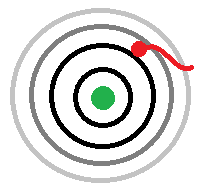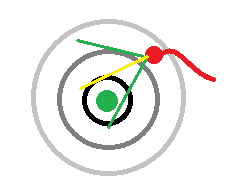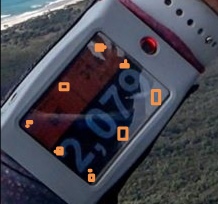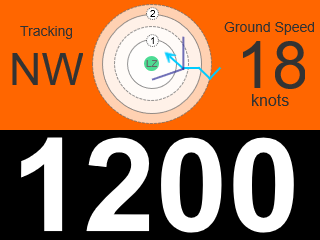That sounds reasonable. I am willing to beta test it if you ever decide to do it. Or, if you have a way to enable way more logging (raw sensor data, etc), I don’t mind flying around with all this enabled, gathering data.
So something I was thinking…
Arrow can only be active in canopy and wingsuit mode. Wingsuit mode: depending on unit orientation. Doesn’t need to be 3D. Unit can probably sense if it’s facing up or down (belly or backfly). For example, one belly, arrow away from body = DZ ahead. Arrow pointing to the body = DZ behind. Perhaps that’s a decent starting point.
In canopy mode, arrow is only active when alti is on somewhat level “surface” and there are no turns. People can bring their hand down to half flare position to check their location.
I am sure you have actual UX experts you can reach out to, and I am not one of them, but if I had a gun to my head, telling me to design workable solution, this would probably be my approach.
Just a thought and I hope it is not a silly one. What about a bullseye type indicator where there is no arrow but a dot that indicates the position of the DZ in relation to the unit. Then I guess it would not matter which orientation the unit is in.

Thanks @yumanskiy - appreciate the continued input however these ideas make big pilot behavior assumptions that could be easily performed incorrectly.
Hi @Bip - I like this out of the box thinking, thank you! The good thing about this is the simplicity. The user wouldn’t know where that red dot actually is though. Sure, it could be North East of the LZ but that’s irrelevant if the user is in clouds or isn’t familiar enough with the area to know their directions.
However, maybe we could show a “tail” on the red dot to indicate the pilots tracking path…

What about if the centre of the bullseye was the jumper and the red dot was the DZ? As long as you have the dot in front of you (Top) you will be heading towards the DZ. If you wanted to get fancy you could add a floating compass ring (so orientation of the unit would not matter). That way you would know whether you were north , south etc of the DZ…
Then we would have the same issue as an arrow. Top of the circle being forwards but a device on a wrist while holding risers would be pointing backwards.
Morning @brent
I’m finding this to be a rather interesting decision,
I now fully dry understand your concerns about the idea on such a feature, along with the difficulty of safely and accurately implementing it.
With the interest in such a feature and your interest in the bullseye concept from @Bip for the ease and simplicity of it.
How about his bullsey idea with a trap cone.
Sort of like you see on strategy games ( not that I’m a gamer)
If the red ball is within the cone, you’re flying in the general direction.
Of its off to one side then you just alter your direction to compensate slightly.
It would be more a " directional guide" or “directional orientation assistant” 

Thanks @mutley - I’m really liking this idea evolution. Even though the problem persists of device orientation this certainly takes things one step closer to being intuitive. The issue of a pilot flying in a strong head wind with a negative ground speed still remains though.
What do you think of a combination of the 2 concepts?

I’ll drop you a slack pm dude, 
I can agree here too. But one of the main reasons i would like a “smart” altimeter is for this feature.
still I think is best option and easiest to decifier.
Late to the game, but making my first post.
I was on a high pull night jump a while back and got a bit lost under canopy. Leaving out the why and the what… This feature would have put me to rest in a ton of ways.
Why not rule out the thinking your hands should be anywhere else aside from toggles in hands and hands on risers for this feature.
Promotes safe flying.
if you are lost… one should assume you’re hands on the rears anyway and the lit logo pointing to the sky.
If the logo is UP you lock orientation.
If the center dot is the target drop zone I’m a huge fan of keeping things simple.
A much more simplified visual reference for finding center.
Simply design the center target as DZ and radius circles to expand or contract based on distance from center. If the radius circles are shrinking smaller you are flying toward the target… if they are growing… you are flying away… bang… wrist orientation doesn’t matter and the problem of arrows pointing all over is solved.

I know there are a lot of considerations to be taken into account with the use of such a feature as mentioned before,
Orientation, negative ground speed and all that, along with potential destractions.
I do like the bullseye idea, but while talking to another jumper, we came up with this idea to but forward too,
Rather than changing one of the box’s at the top for a small arrow or bullseye, use the orientation of the device, ( top of the screen references forward regardless) and use the corners as a quick glance orientation,
Top center = ahead
Top left / right = off to the left or right of center,
Left and right sides = left or right,
And so on with the bottom of the scream reference to rear.
Just a thought to put out there.
Sorry for my bad english google! Brent’s answers are particularly sensible and reasonable. Why in this case do not do as for boat tracking? That is, the point of the LZ is indicated along with your position and direction. Can we use maybe an SOS button? I jumped once above the clouds and I avoid doing it again.
If the purpose of this function is just to aid you through cloud or help you on a long spot I don’t think you really need a map that will guide you all the way to the LZ.
First of all, I’m a dumbass and don’t really understand how the hardware works haha, but could you do something like a ground speed or distance to LZ counter accompanied with a green or red flashing background. Green means your heading towards LZ red means away. This removes the device orientation and negative ground speed issue.
Lots of great updates on this thread. Thank you @jamiesda, @Fred_Polatouche, @mutley, @FluffyBunnyz and @Mjklingler.
I am almost ready to start getting this feature developed for the beta firmware channel. No matter the chosen UI implementation, it would be wise to only enable it when in canopy mode above 1000ft then revert to simple altitude.
The below UI is a basic mockup that will be refined throughout the testing phase. Your continued thoughts are welcome…

Wicked! Looking forward to how this turns out. I would imagine this would and should only be a tool for high pulls / quick glance and should disappear at a certain height leaving only the important stuff (maybe that’s what you just said… just clarifying).
I would almost raise the awareness to 1.5k at 1k you should already be focused and starting downwind assuming a normal pattern.
Experience leveled jumper would only be using this on a high pull, or quick directional reference. ((keeping it as simple as possible would be ideal))
a student would have a much larger canopy, pulled higher, with much more air time and shouldn’t be using that other than to help match up with what they are seeing. You don’t want them locking eyes on that thing under 2k. Assuming they pulled at student level.
just random thoughts. Take em as they are 
Add a disclaimer to enable the feature too, then that covers the use of it. I confirm I have X jumps, am X licence holder (B or above for UK/USPA?). Students should not be using these devices, our CI would never clear it for a student. As an aside, this weekend we had tandems all over the place, they could see the DZ when they left the plane, but the cloud came in so quick they lost directional awareness, this feature would almost certainly have helped.
Good thought.
Well, section 7 of the BPA operations manual requires C license and above to carry a GPS device, although it doesn’t state what “GPS” means. It can be a GPS navigator?